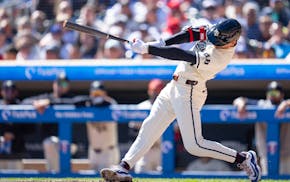FORT MYERS, FLA. – The first two video challenges in major league history went in the Twins' favor Monday. The Twins believe the entire take-another-look system ultimately will go in baseball's favor, too.
A pair of bang-bang plays at first base were reviewed by umpires watching digital replays during the Twins' 12-2 exhibition victory over Toronto at Hammond Stadium, the first time in big-league history that a tool other than human eyes and ears was used to determine what happened on the bases.
"For lack of a better word, we're pioneers at it," said Twins coach Terry Steinbach, who managed the split-squad team in the game but never challenged a call. "We have the opportunity to use this advantageously to the game of baseball, to prevent mistakes that affect the outcome of ballgames. We have the chance. To me, that's a pretty exciting prospect."
Monday's game was the first to be played under the video-challenge rule that was unanimously adopted this winter, a system that allows managers to trigger a review by an umpire watching slow-motion replays. It came into play in the sixth inning, when Twins outfielder Chris Rahl hit a sharp grounder to Toronto shortstop Munenori Kawasaki. The throw to first was high, and first baseman Jared Goedert lost contact with the base in order to catch the ball, with umpire Fieldin Culbreth ruling Rahl safe.
Blue Jays manager John Gibbons agreed with the call, but he immediately walked over and challenged Culbreth's decision anyway, just to test the new system. Culbreth donned a headset next to the Toronto dugout and asked umpire Brian O'Nora, stationed in a nearby TV truck, to watch replays and render a verdict. (During the regular season, replay umpires will watch from an MLB control room in New York.)
"When [Gibbons] came out and they went to the replay, I was thinking, 'Maybe I'm the first one. This could be kind of cool. I might get on ESPN or something,' " Rahl said. "It was exciting. Interesting to see the process and how it works. I thought it went fairly well and was pretty quick. They got the call right, so that's the point of the process."
Actually, the video wasn't entirely conclusive, but with only two angles to work with from the Fox Sports North feed — most stadiums will provide 10 or more during the regular season — O'Nora said he saw enough to uphold the call. "You could see [Goedert] was up in the air, and when he was coming down, he wasn't on the base," said O"Nora, one of three umpires who rotated into the replay truck for three-inning stints. "When I could definitely tell he was on the base, the Twins runner's foot was already on the base."
The call took 2 minutes, 34 seconds to confirm, longer than the 2 minutes that baseball officials hope it will take once everyone is more familiar with the system, but not so long that anyone minded Monday.
"I didn't think it took too long," Rahl said. "It seemed like they got it done pretty quickly, in a timely manner. They went through the whole thing and got the call right."
The crowd got a little more impatient two innings later, when Gibbons requested a review of Doug Bernier's infield single, a grounder to second that turned into a close play at first. Gibbons could not challenge the play because he had already used that option unsuccessfully, but from the seventh inning on, umpires can opt to order a review on their own. When O'Nora granted Gibbons' request and headed toward the headsets, several fans briefly booed the delay, which lasted 2:03.
Once again, the Twins runner was confirmed as safe.
"I had the play standing because I just couldn't confirm that it was 100 percent [wrong]," said Culbreth, who was taking his turn in the replay truck at the time. "Definitely, it was not conclusive enough to overturn. So the play stands."
Steinbach said it was fascinating to watch the new rule put into action. He almost had an opportunity to challenge a call himself, too.
In the first inning, Aaron Hicks slid home on Brian Dozier's double, safe because the relay to the plate was wild. But had Hicks been tagged out, Steinbach would have utilized his challenge to enforce another new rule. Toronto catcher Dioner Navarro, he said, was blocking the plate before the ball arrived, a tactic outlawed this season.
"I don't think there was a lane there. [Plate umpire Bob Davidson] said he didn't see whether there was a lane or not, [but] he thought there was," said Steinbach, a major league catcher for 14 seasons. O'Nora checked the play when he was in the replay truck, and reported back, Steinbach said, that he was correct. "So that would have been one of those where, if he would have been tagged out, the call potentially could have been overturned."
Maybe next time. The Twins were happy to go 2-for-2, and happy to be part of a new era in baseball.

Live: Minnesota United at Charlotte FC. Follow on Gameview.
Jameson Taillon comes off the injured list and helps the Cubs beat the Marlins 8-3
T-wolves take NBA's best defense into series vs. Suns, but can it stop Durant-Booker-Beal trio?


